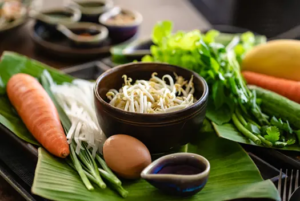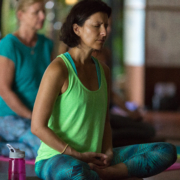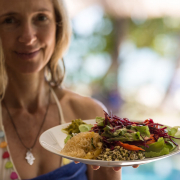 https://samahitaretreat.com/wp-content/uploads/2023/11/IMG_1290-2-scaled.jpg
1920
2560
Kirsten Mia
http://samahitaretreat.com/wp-content/uploads/2024/01/samahita-logo-v2.svg
Kirsten Mia2023-11-21 21:09:402023-11-21 21:09:40Music makes the world go round!
https://samahitaretreat.com/wp-content/uploads/2023/11/IMG_1290-2-scaled.jpg
1920
2560
Kirsten Mia
http://samahitaretreat.com/wp-content/uploads/2024/01/samahita-logo-v2.svg
Kirsten Mia2023-11-21 21:09:402023-11-21 21:09:40Music makes the world go round!Nutritious AND Delicious!
Finding a balanced diet for health and vitality…
We need to eat to survive. Human beings however, have taken eating to a whole other level. Food is not just something we consume to stay alive, it has become part of who we are, our communities and cultures. It connects us on a deeper level not only to each other, but to the places we live and the plants and creatures we rely on for our sustenance. We have developed complex, global agricultural and food production systems that have become ever more convenient, making a wide range of foods available to us at the tips of our fingers! From Twinkies to chicken nuggets, what will we think of next to tantalize our tastebuds?! Whilst Twinkies may be a tasty treat, most of us know they aren’t exactly good for us (“empty calories”), so today we’ll learn a bit more about nutrition and some simple tips and advice to create a plate full of healthy, delicious and nutritious food.
Nutrition 101 – Macros
Nutrition is the process by which we take in and utilize food substances to support life and good health. The 7 classes of nutrients are: Carbohydrates, fats, protein (the macronutrients), vitamins and minerals (the micronutrients) plus fiber and water. The macros are needed in higher quantities, and they provide the fuel/energy for the body. (Although the starchy and refined carbs are not considered an essential nutrient) Grains, fruit, veg, legumes, refined carbs are all examples of carbohydrates (sugars & starches). Fruits and veg not only provide energy, they also provide fiber and most of the vitamins and minerals we need.
Fats or fatty acids are classified into 3 categories, saturated (mostly from animal sources), unsaturated (Omega 3 and 6) and trans fats (rare in nature and are shown to be detrimental to human health, created in an industrial process called hydrogenation). Fats are essential for cellular function, energy, to make hormones and absorb key vitamins. Most fatty acids can be produced by the body, but we need to ingest the Omegas, particularly more Omega 3. (Highly processed seed/vegetable oils contain too much Omega 6 relative to 3).
Proteins (amino acids) are the building blocks and basis for the body’s structure (hair, skin, muscles) and are an essential nutrient playing a vital role in building and repairing tissues. There are about 20 different amino acids (10 are essential) and most need to be obtained by ingesting food with varying combinations of these amino acids. Most animal sources of protein contain the 9 essential amino acids (complete proteins) and most plant proteins (incomplete) will need to be combined with others to make sure you’re getting the variety you need. Vegetarians and vegans may need to increase their protein intake due to the bioavailability and combinations of amino acids. For adults, some guidelines on protein intake per kg of bodyweight are as follows: Sedentary – 1.2-1.8g/pkg / Active healthy weight – 1.4-2g/pkg / Overweight – 1.2-1.5g/kg. If you’re looking to build muscle 1.6-3g/kg.
Micros, water and fiber
Vitamins and minerals, known as the micros, of which 27 are essential nutrients, but are needed in much smaller amounts. They are important for bodily processes like brain and hormone function, building bone and things like digestion. Vitamin D is synthesized in the skin in the presence of UVB so if you’re getting outside in the sun, you won’t need to supplement or obtain enough from food sources. On a vegan or vegetarian diet a bit more planning and forethought is needed to make sure you’re getting all the essential nutrients. (Some deficiencies to be aware of: Vit B12, Vit D, Vit K2, iodene, iron, calcium, zinc, choline, omega 3 and protein) Water is absolutely essential, our bodies are made up of about 65% water so it’s important we stay sufficiently hydrated. (Water – The Real Elixir of Life – Samahita Retreat) Last but not least is fiber, a carbohydrate that has 3 primary mechanisms: bulking, viscosity and fermentation. Insoluble fiber aids peristalsis, some soluble and insoluble fibers produce a solution of high viscosity (essentially a gel) which slows the movement of food through the intestines, and fermentable fibers are used as food by the gut microbiome.
A healthy plate of food
Nutrition is certainly not a 1 size fits all approach and if needed, seek professional advice and help if you’re trying to lose weight, manage diabetes or other health conditions, deal with an eating disorder, addictions or hormonal changes. The amount of calories needed daily will also vary, depending on age, sex, activity levels and personal goals. I won’t go into the specifics of any particular group, but here are a few things to consider:
- At least 5 portions of fruit and veg per day (if you aim to fill half your plate with these colorful carbohydrates you should get a great variety of vitamins and minerals and enough fiber)
- Choose wholegrains like quinoa, oats, millet and wholewheat bread instead of refined/processed carbs to boost nutritional values and keep you fuller for longer
- Have protein at every meal to keep you satiated and to maintain muscle mass, choose high quality lean protein sources like lean beef, fish, skinless chicken or tofu to keep saturated fats in check
- Include healthy fats like avocado, nuts, seeds and coconut or olive oil to support brain function
- Make sure you are drinking enough water (with electrolytes if you’re active or live in a tropical climate)
- Limit processed foods and sugary drinks (generally these kinds of foods have long ingredients lists, added sugars, artificial colors, flavours and preservatives)
- Try to incorporate fresh herbs like basil, coriander, rocket, parsley or mint into your meals, they are full of vitamins and give your food great flavours!
Cooking a delicious, healthy, wholesome and affordable meal is not difficult, it does perhaps require a bit more planning and a few more minutes of preparation time, but it’s totally worth it. Getting your kids and family involved in the buying, prepping, cooking and tasting of food in a positive way will also help to formulate a deeper connection with your food, family and your health. Have meals around the table, turn off the TV and smartphone and enjoy mealtimes together. Eat mindfully, chew properly and have gratitude for the food on the plate. Your wellbeing matters, and it all starts with the food you choose to nourish your body with. Here at Samahita we do our best to bring you food that is seasonal, organic, free from additives and preservatives and is made with love and care by our amazing team of chefs. Cuisine | Samahita Retreat Enjoy nutritious and delicious food!
References:
https://en.wikipedia.org/wiki/Human_nutrition
https://www.who.int/news-room/fact-sheets/detail/healthy-diet
https://www.webmd.com/diet/what-are-macronutrients
https://www.healthcentral.com/nutrition/micros-vs-macros
https://examine.com/guides/protein-intake/
https://www.medicalnewstoday.com/articles/carbohydrates-are-they-really-essential
https://www.wellnesscreatives.com/nutrition-industry-statistics/
https://globalnutritionreport.org/documents/896/Executive_summary_2022_Global_Nutrition_Report.pdf
https://cleangreensimple.com/article/vitamins-supplements-vegans-vegetarians/
More from the Samahita Blog







